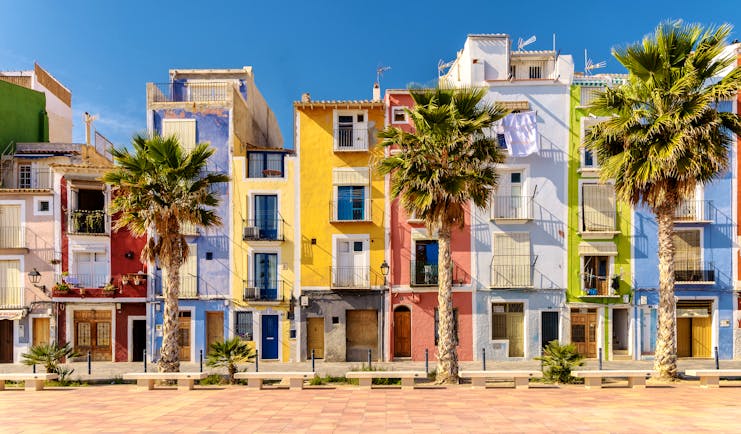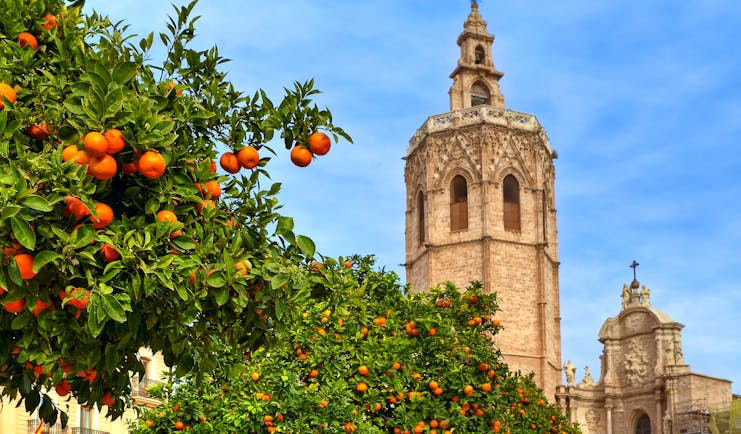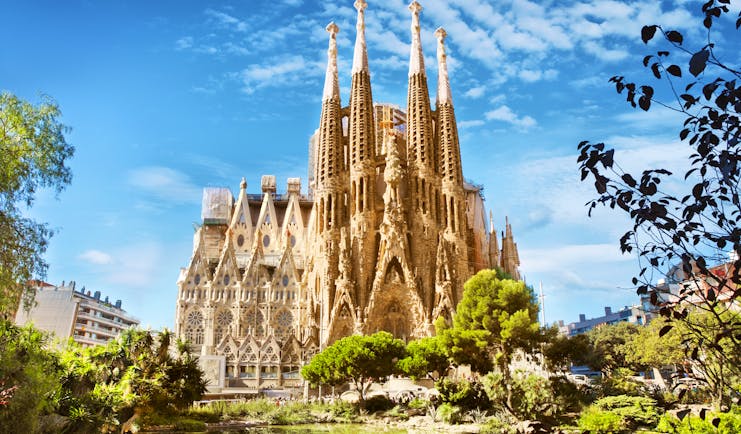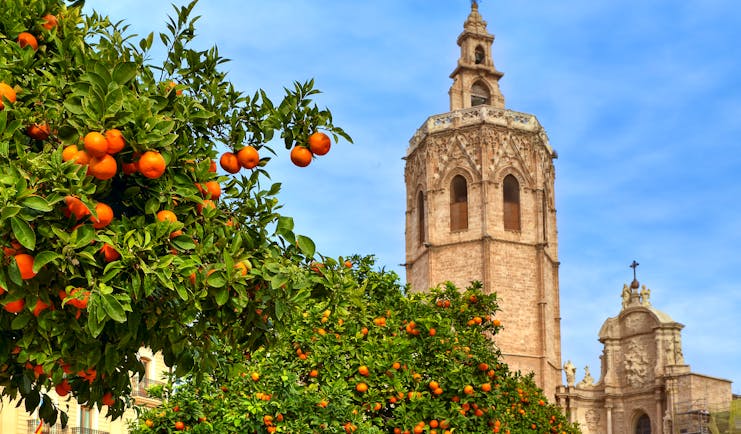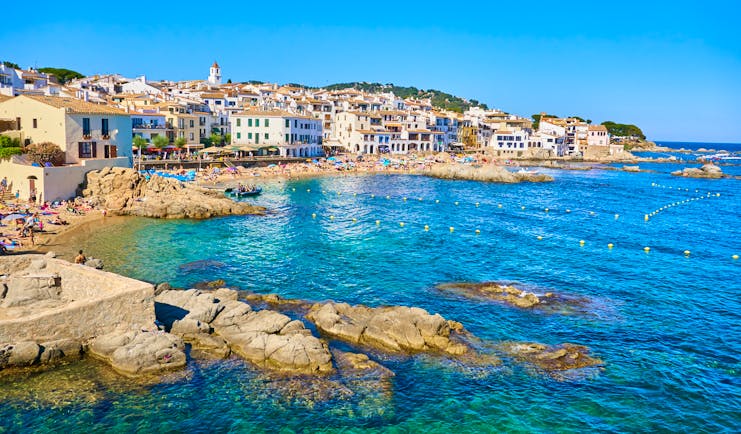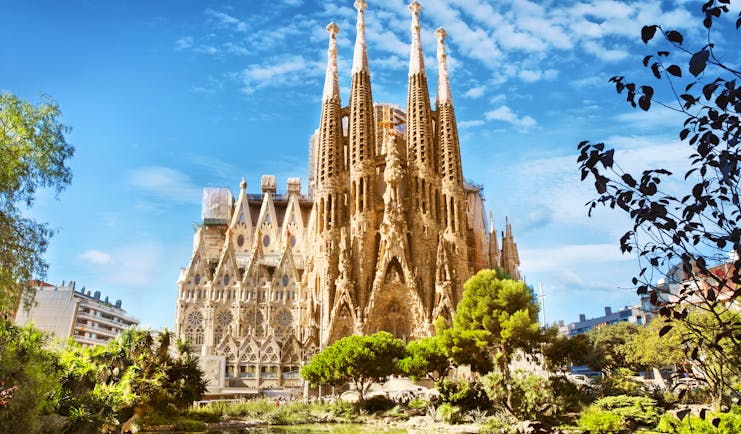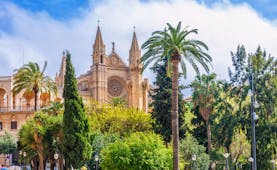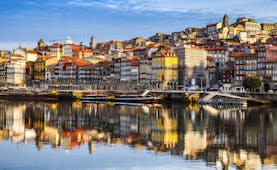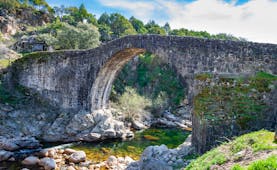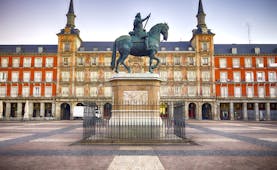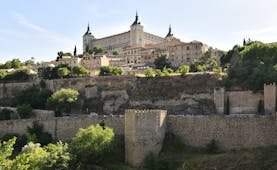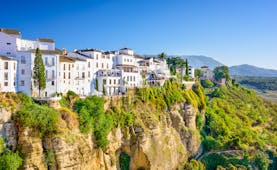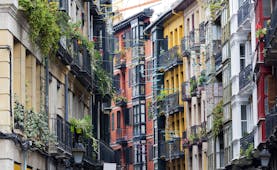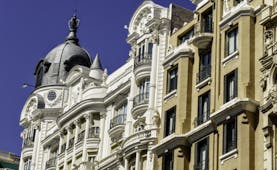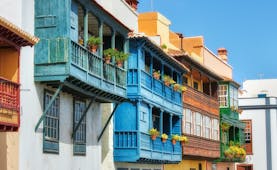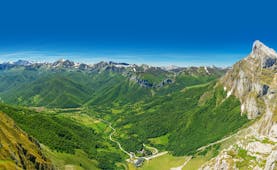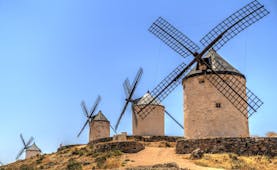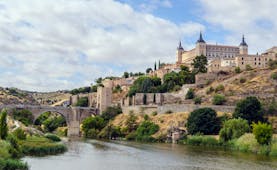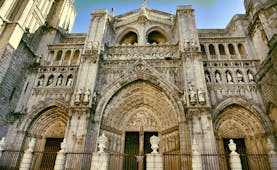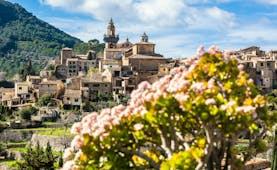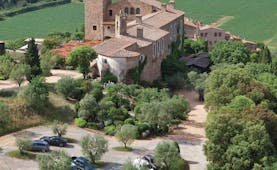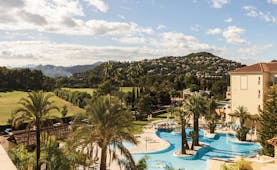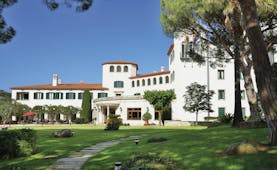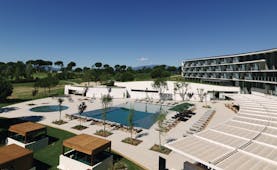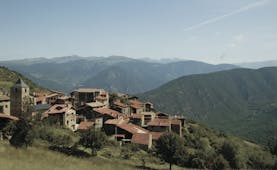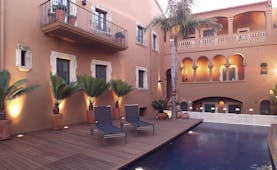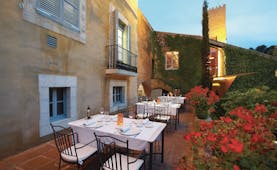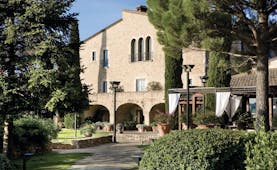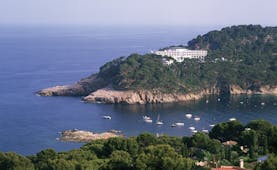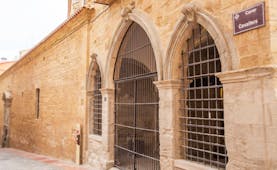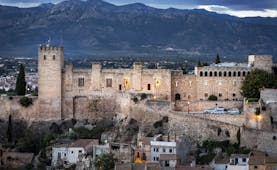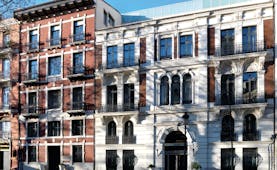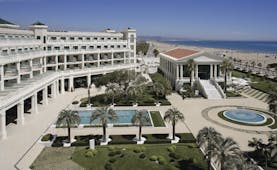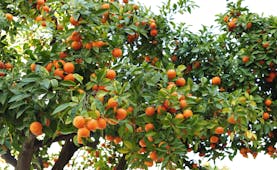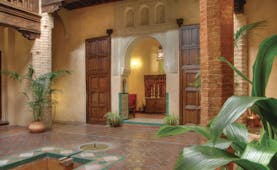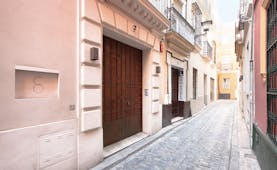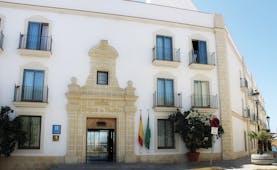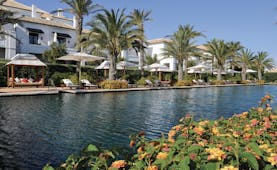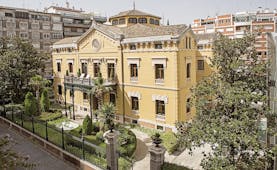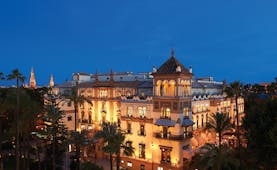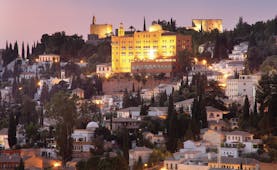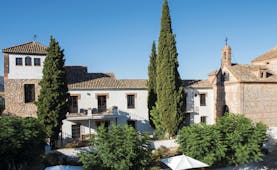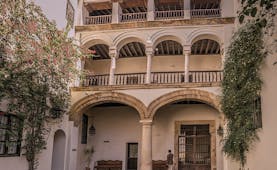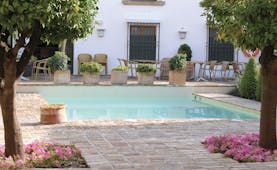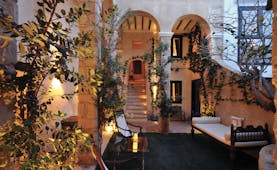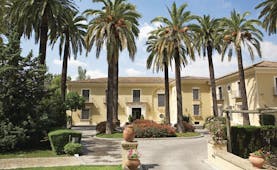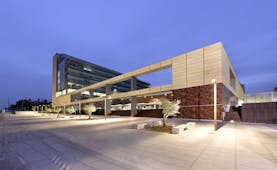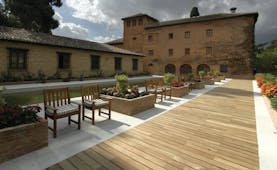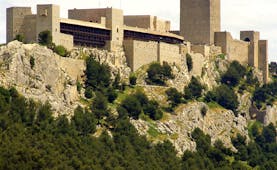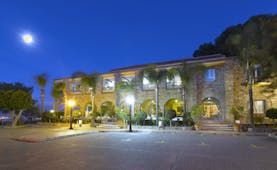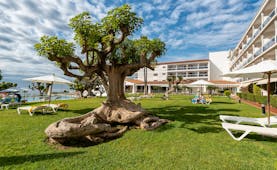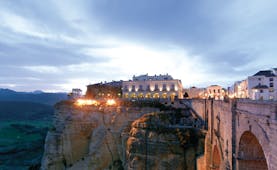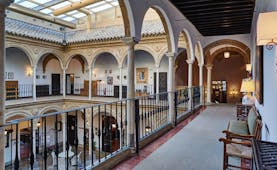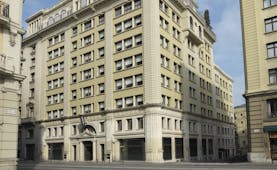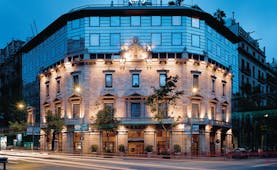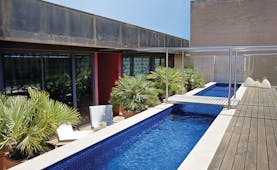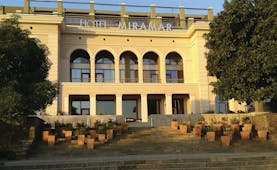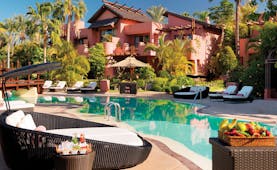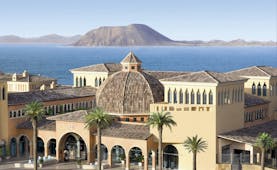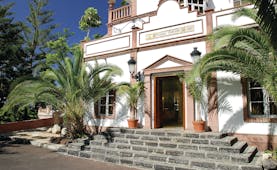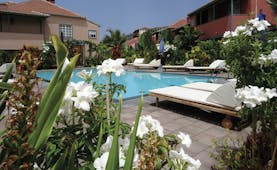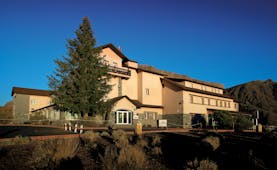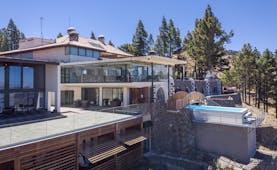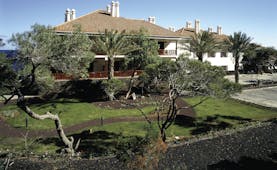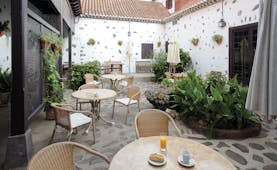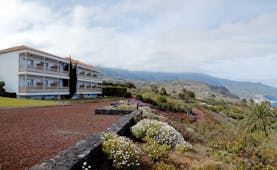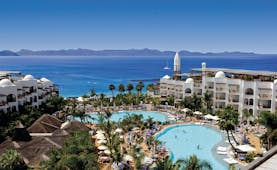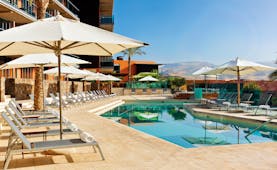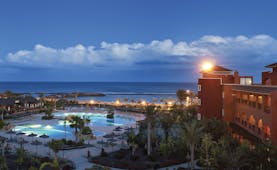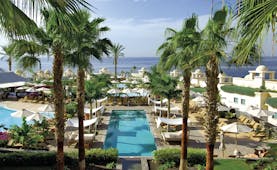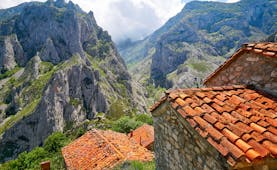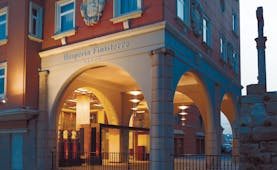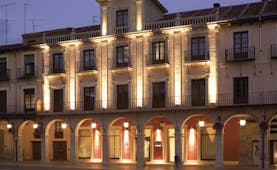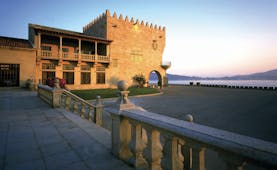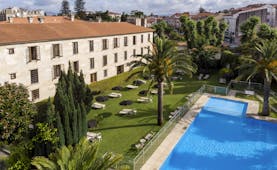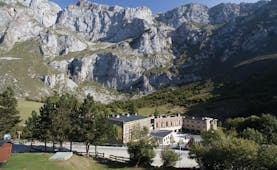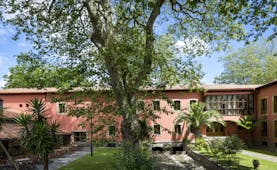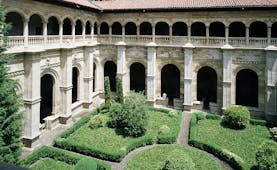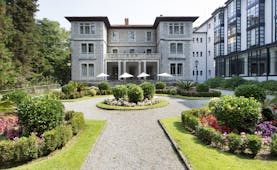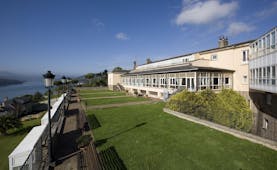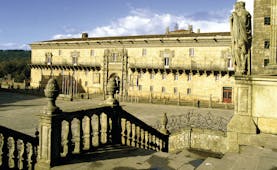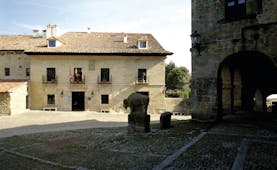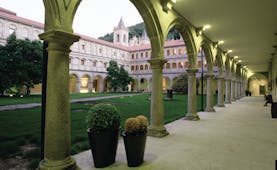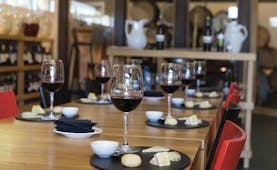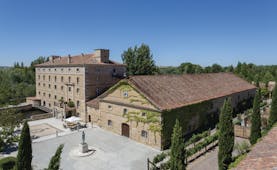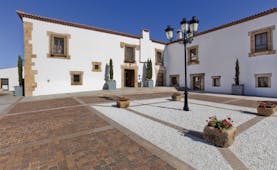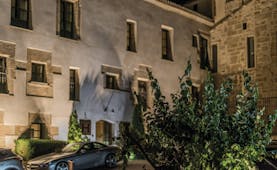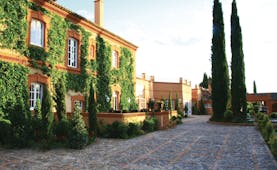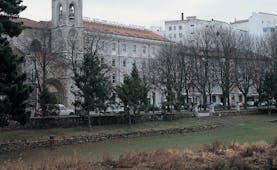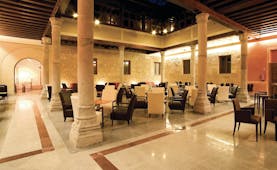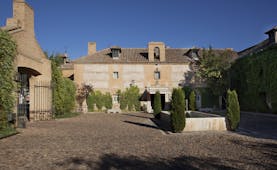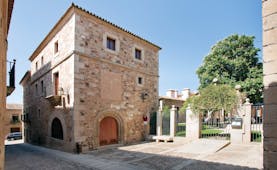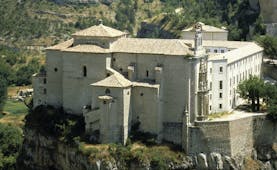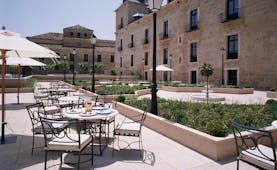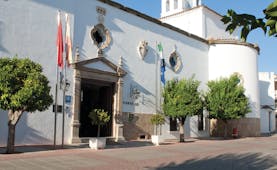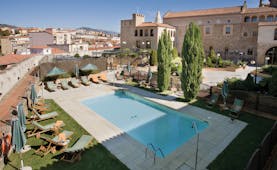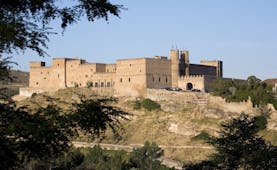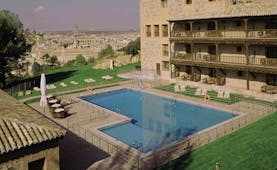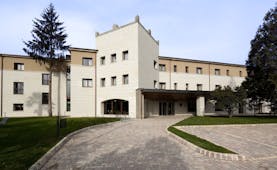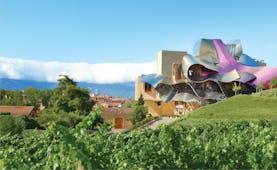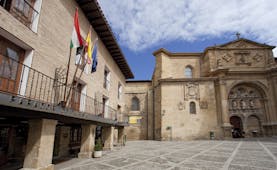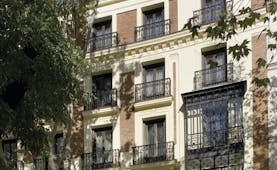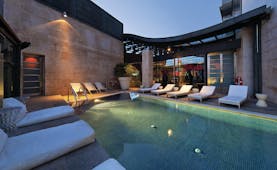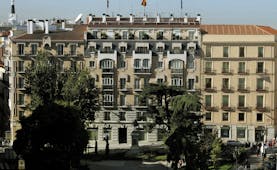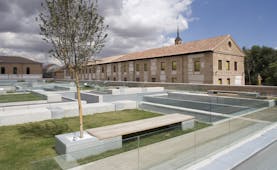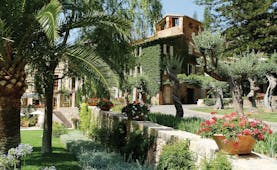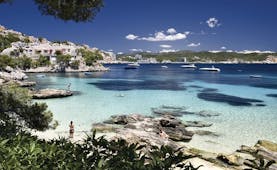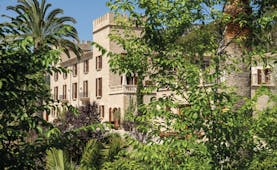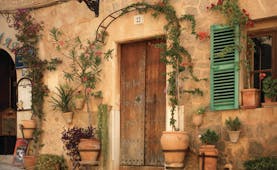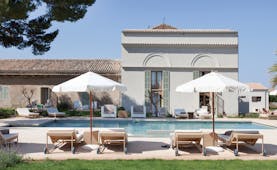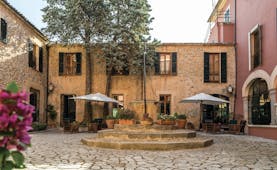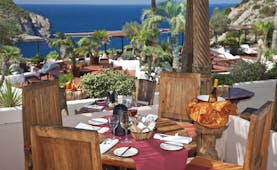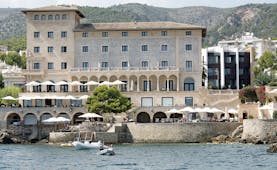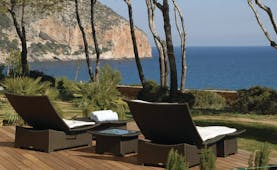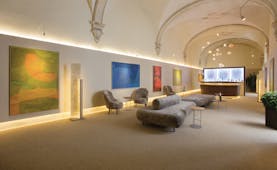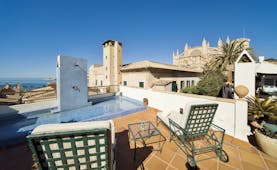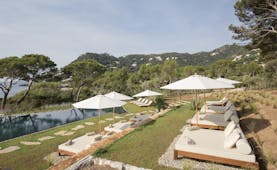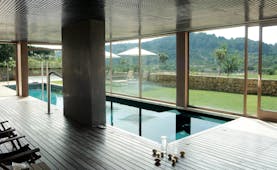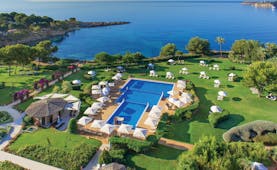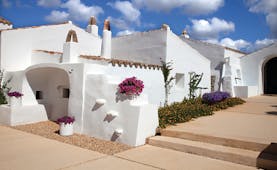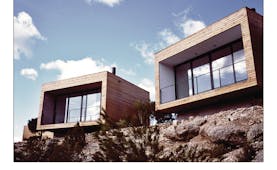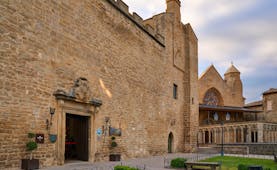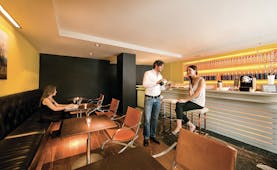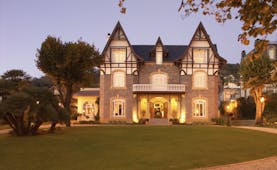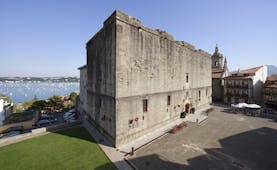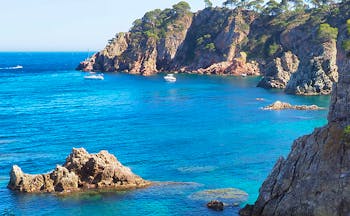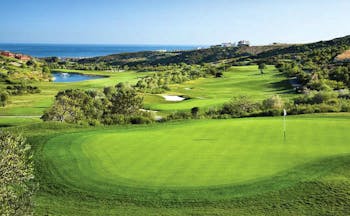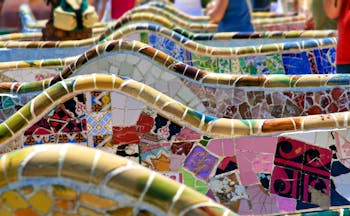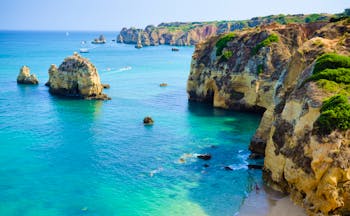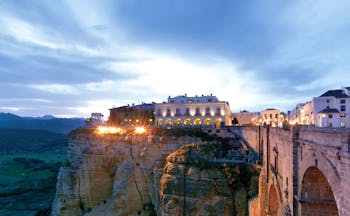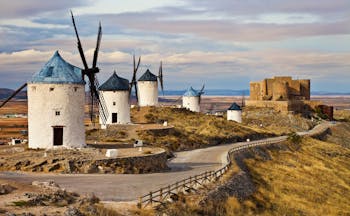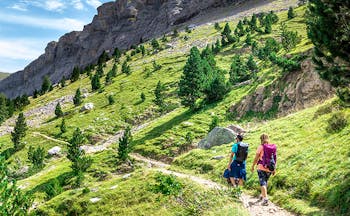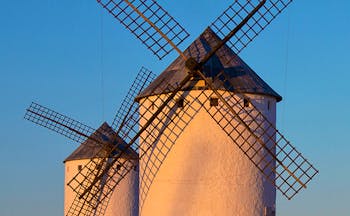Costa Blanca to Catalonia luxury fly-rail touring holiday
Start your holiday with a direct flight from London to Alicante. This city on the famous Costa Blanca is often overlooked by visitors, however venturing into the city centre you will find the beautiful Barrio de la Santa Cruz, Alicante’s old town, with its narrow streets and colourful houses. Alicante is a very attractive port city with long sandy beaches, beautiful parks and bustling plazas as well as a favourable climate year-round. Spend a few days here to settle into the Spanish pace of life before boarding your first train along the Spanish coast. The second stop on your rail holiday is the semi-independent region of Valencia and you stay a few days in its regional capital. Proud of its cultural independence, use your stay here to discover Valencia’s history, language and cuisine. This is the third largest city in Spain, and we suggest that you spend your days here exploring the historic monuments such as the 15th century silk exchange and cathedral as well as the ultra-modern buildings in the City of Arts and Sciences. No trip to Valencia would be complete without sharing a delicious paella, the iconic dish of saffron-infused rice which originated here. Head to the golden sands of the long beach to relax in the sun and wind down in the evenings at your hotel or in one of the city’s vibrant bars. You re-join the Euromed railway on the following day and journey along the Costa Dorada – named for its beautiful golden sand. The train takes you to Barcelona where you perform an easy platform change and continue to Girona. Sitting beside the River Onyar, Girona is a historical city in north-eastern Catalonia with medieval walls, narrow winding streets and the remains of a Roman fortress. Spend your time here exploring the Passeig Arqueològic walkway, visiting museums, galleries and markets. It is then a quick journey back to Barcelona where you round off your holiday. First founded by the Romans, Barcelona is now a dynamic and cosmopolitan city on the Mediterranean coast which is charming and exciting all at once. The capital of Catalonia is famed for its staggering concentration of Gothic architecture as well as surreal works of Antoni Gaudi including the Sagrada Familia, making it one of the most visited cities in Europe. Unique architecture, a rich culture with art galleries and museums abound, gourmet restaurants, lively bars, designer boutiques, golden beaches, parks and gardens – Barcelona has it all and is a memorable finale to this tour of Eastern Spain. On your last day in Spain you head to the airport for your flight back to the UK.
Highlights
Alicante • Barrio de Santa Cruz • Postiguet Beach • Castillo de Santa Barbara • Valencia • City of Arts and Sciences • Paella • Valencia Cathedral • Malvarosa and Las Arenas Beaches • Girona • Passeig Arqueològic • Barri Vell • Barcelona • Sagrada Familia
Day by day
Start your holiday with a flight to Alicante. It is a short taxi journey from the airport to your hotel in the city. Use the rest of the day to acclimatise and settle in to your room.
Enjoy breakfast at your hotel before starting your exploration of Alicante in earnest. The resorts of the Costa Blanca attract a strong contingent of international visitors each summer, thanks to the warm climate and beautiful sandy beaches, however, the city of Alicante retains its charm. In the heart of Alicante you will find the beautiful Old Quarter – the Barrio de Santa Cruz, where you can while away the time exploring the cafes, shops and restaurants hidden within the narrow streets. The city has its share of cultural attractions including the hilltop castle of Santa Barbara, reachable on foot or using the elevator, from where you can admire panoramic views of the city and bay. In the town centre you will also find the Contemporary Art Museum, Archaeological Museum, Basílica de Santa Maria and the Mercado Central. We highly recommend visiting the market for lunch (it is open until 14:30 hrs every day except Sundays) and offers nearly 300 stalls selling local produce including seafood, meats, cheeses and bread. Your hotel is located within easy reach of the stylish port area as well as the old quarter and walking north-eastwards along the promenade brings you to the sandy beach of El Postiguet. Spend your evening dining at the hotel or at one of the many local restaurants which can be reached within a few minutes’ walk. Villena is passed next, best known for the Atalaya Castle and wineries found here, before the track swings eastward towards the coastline.
You have a relaxed morning at your hotel before heading to the train station around midday. Your train journey veers inland from Alicante travelling through a patchwork of fields and groves. Just after passing the station on Novelda-Aspe, you may be able to see the hilltop Castillo de la Mola to the left of the train which was built by Islamic occupiers in the 12th century. Continuing through landscapes of ember-orange and olive-green you circumnavigate the city of Elda, passing through a tunnel under the mountainous landscape of the Sierra del Cid. The surroundings become greener as the track navigates between bounteous fields and rolling hills, emerging into the flatlands surrounding Valencia. You pass a little to the west of Albufera Natural Park and pull into Valencia Joaquin Sorrolla station in the mid-afternoon. From here we recommend taking a taxi to your hotel where you settle in and can take a relaxed stroll around the old town before dinner.
You have two whole days to enjoy the city. Valencia is the third-largest city in Spain and capital of the semi-independent region which takes its name. This is one of Europe’s capitals for culture and is of particularly well-known for its iconic City of Arts and Sciences (Ciudad de las Artes y las Ciencias). Designed by local architect Santiago Calatrava, you will find the aquarium, opera house, science museum and 3D cinema amongst the ultra-modern buildings. Head into the old town to discover more of Valencia’s past and historical buildings such as the UNESCO-recognised Silk Exchange. The neighbourhood of El Carmen is one of the most important parts of the city and it is here that visitors will find Saint Mary’s Cathedral which houses a Holy Chalice (claimed to be the Grail). Take time off from the busy city centre with a walk along the long, sandy beaches of Malvarosa and Las Arenas, or perhaps venture outside the city to the nearby Albufera Natural Park for incredible sunsets over the wetlands. Return to Valencia in the evenings to make the most of the local cuisine, this is the traditional birthplace of paella, and the vibrant nightlife.
Your train leaves Valencia just after 9am this morning so you head to the station after a quick breakfast. This second stretch of the Euromed railway between Valencia and Barcelona stays much closer to the coast than your first leg. Leaving Valencia, you are transported northwards through the towns of Castellón de la Plana, Benicàssim and Vinaròs. Known as the Costa del Azahar or Orange Blossom Coast, the scenery from your train window consists of wide groves of orange and lemon trees, nature reserves and protected parks. At Oropesa the train track runs right next to the sandy beach of La Concha before continuing through the town. A few minutes after leaving Torreblanca you cross the river and looking up at the hill to the right should catch a glimpse of the white-washed Hermitage of Saint Lucia and Saint Benedict that shines above the trees. The track skirts inland around the Sierra d’Irta Natural Park and then returns to the coastal towns of Benicarló and Vinaròs. Shortly afterwards, you leave behind the region of Valencia and cross into Catalonia. You will cross over the mighty Ebro River at Amposta, watching it rush towards its delta, and next come to L’Ampolla. This town marks the beginning of the Costa Dorada or Golden Coast, so named for its stunning sandy beaches. You’ll catch views of the sea between buildings, trees and grassy fields as you work your way north along the coast. The track takes you along the edge of the dense green areas of Senda Mediteraneo and Cap de Santes Creus just before reached L’Ametlla de Mar. More beautiful vistas are promised ahead as the track stays close to the coast as it passes Illot del Torn and the beach here. The popular tourist resorts of Cambrils and Salou are passed next before the train reaches Tarragona. This port city hosts several ancient ruins including a Roman Amphitheatre, Necropolis and traces of the Forum in the medieval Old Town. The railway takes you past the marina and you will see the amphitheatre on the left-hand side of the track as you travel alongside the golden El Miracle Beach. The stretch of railway north of Tarragona is particularly attractive as you pass several more beaches to eventually reach Sitges from where it is a short journey to Barcelona Sants. You disembark here and change onto another service which will take you on the 40-minute trip to Girona. Leaving Barcelona behind the railway follows the River Besòs heading north and east. The scenery of this area is much more vibrant than the southern landscapes and white-washed houses are replaced with ochre-hued buildings with terracotta roofs. You pull into Girona just after lunch time and take a taxi to your hotel to check-in. The rest of the afternoon is spent at leisure walking from your central hotel around the old quarter.
Use your time in Girona to explore this historical city which sits on the River Onyar. Perhaps start your day in the Jewish neighbourhood of El Call, a maze of narrow cobblestone lanes which takes you back 500 years with very little change. Those wishing to learn more about the role of the Jewish population in Girona can also visit the Jewish Museum. If you’re in Girona on a Tuesday or Saturday morning, the Ribes Del Ter market is a must. Located in Devesa Park you’ll find over 200 stalls here selling everything including local produce, gifts and fruits. On the afternoons of the second and fourth Fridays each month you can also visit the craft and artisan food fair which is held in Placa Miquel Santal. After lunch, head up to the city walls for a walk along the Passeig Arqueològic. These spectacular walls were built in the 9th century and offer amazing views over the city and surroundings, especially from the towers which are scattered along the route. If time allows, visit Girona Cathedral, enjoy a coffee or the Placa Independencia and take in views of the colourful houses alongside the river from the Eiffel Bridge or Pont Pedra.
There are frequent trains from Girona to Barcelona and we recommend spending the morning relaxing over breakfast and a coffee before heading to Barcelona. This gives you a second morning to try and catch one of the markets if you haven’t been able to so far, or perhaps visit one of the city’s museums or galleries. The journey back to Barcelona Sants takes a little over 40 minutes and you arrive mid-afternoon. Take a taxi to your hotel to check-in and spend the rest of the day starting to get your bearings in this fascinating city.
Your visit to Barcelona is only limited by your time and energy with a wealth of attractions to suit all interests. La Rambla, Spain’s most famous street which is busy at almost any time of the day or night with flower stalls, tarot readers, musicians and mime artists lining the wide walkway is an ideal place to start. Be sure to visit the Mercat Boqueria which is located off this street for fresh fruit, smoothies and delicious treats. The Gothic quarter, a maze of narrow streets and plazas in the old town, has architecture dating back to the 14th and 15th centuries. This historic area is home to Catalonia’s government building, the town hall, a former royal palace and the imposing and intricately-decorated La Seu Cathedral, which includes a beautiful cloister. We recommend visiting Montjuic, a fortress-topped hill in the south of the city with museums, art galleries and restaurants dotted throughout the spacious gardens. This is also the setting of the 1992 Olympic stadium, the large open space enjoys panoramic views of the city and sea, and is accessible by cable car from the port, by funicular from the base of the hill, by bus or on foot. The Eixample District cannot be missed; a vast area towards the north of the city which was built according to a grid system and is full of unique buildings which were designed in a ‘Modernista’ (Catalan Art Nouveau) style by the famous Antoni Gaudí and his contemporaries. The most famous building which was designed by Gaudí is the Sagrada Familia, an unconventional church building which is filled with symbolism but is still unfinished. Other famous works of art which feature Gaudí’s trademark curved lines, decorated chimneys, elaborate wrought iron and mosaic decorations include Parc Guell, a colourful park which is a UNESCO World Heritage Site; Casa Batlió, a house with a fascinating interior and exterior and La Pedrera, a curved apartment building. Take some time off from your busy site-seeing schedule with an ice cream in Parc de la Ciutatella, a popular park with gardens, a boating lake, a zoo, several museums and the striking Catalan Parliament building. The harbour area, where almost 3 miles of sandy beaches meet the Olympic port and the older area of Barceloneta, is known for its numerous fish restaurants and is a good option for dinner. There is a wide choice of restaurants covering every taste in Barcelona with traditional dishes including ‘crema catalana’, ‘fideuá’ (like paella but with pasta rather than rice) and ‘zarzuela’ (a seafood stew). Head back to your hotel in the evenings to enjoy a drink on the rooftop whilst admiring the city lights below.
Depending on the time of your flight, you may have the morning or afternoon free to continue to enjoy Barcelona. Take a taxi back to the airport for your return flight.
It has been a lovely holiday & once again, you did not disappoint. Thank you again for everything. We look forward to contacting you again for our next adventure.Mrs H, July 2025
Holiday price guide Prices from £2,580 per person based on two people sharing a double or twin room.
Holiday Code SNFR09
Call us on 01392 441245
Costa Blanca to Catalonia luxury fly-rail touring holiday
Start your holiday with a flight to Alicante. It is a short taxi journey from the airport to your hotel in the city. Use the rest of the day to acclimatise and settle in to your room.
Enjoy breakfast at your hotel before starting your exploration of Alicante in earnest. The resorts of the Costa Blanca attract a strong contingent of international visitors each summer, thanks to the warm climate and beautiful sandy beaches, however, the city of Alicante retains its charm. In the heart of Alicante you will find the beautiful Old Quarter – the Barrio de Santa Cruz, where you can while away the time exploring the cafes, shops and restaurants hidden within the narrow streets. The city has its share of cultural attractions including the hilltop castle of Santa Barbara, reachable on foot or using the elevator, from where you can admire panoramic views of the city and bay. In the town centre you will also find the Contemporary Art Museum, Archaeological Museum, Basílica de Santa Maria and the Mercado Central. We highly recommend visiting the market for lunch (it is open until 14:30 hrs every day except Sundays) and offers nearly 300 stalls selling local produce including seafood, meats, cheeses and bread. Your hotel is located within easy reach of the stylish port area as well as the old quarter and walking north-eastwards along the promenade brings you to the sandy beach of El Postiguet. Spend your evening dining at the hotel or at one of the many local restaurants which can be reached within a few minutes’ walk. Villena is passed next, best known for the Atalaya Castle and wineries found here, before the track swings eastward towards the coastline.
You have a relaxed morning at your hotel before heading to the train station around midday. Your train journey veers inland from Alicante travelling through a patchwork of fields and groves. Just after passing the station on Novelda-Aspe, you may be able to see the hilltop Castillo de la Mola to the left of the train which was built by Islamic occupiers in the 12th century. Continuing through landscapes of ember-orange and olive-green you circumnavigate the city of Elda, passing through a tunnel under the mountainous landscape of the Sierra del Cid. The surroundings become greener as the track navigates between bounteous fields and rolling hills, emerging into the flatlands surrounding Valencia. You pass a little to the west of Albufera Natural Park and pull into Valencia Joaquin Sorrolla station in the mid-afternoon. From here we recommend taking a taxi to your hotel where you settle in and can take a relaxed stroll around the old town before dinner.
You have two whole days to enjoy the city. Valencia is the third-largest city in Spain and capital of the semi-independent region which takes its name. This is one of Europe’s capitals for culture and is of particularly well-known for its iconic City of Arts and Sciences (Ciudad de las Artes y las Ciencias). Designed by local architect Santiago Calatrava, you will find the aquarium, opera house, science museum and 3D cinema amongst the ultra-modern buildings. Head into the old town to discover more of Valencia’s past and historical buildings such as the UNESCO-recognised Silk Exchange. The neighbourhood of El Carmen is one of the most important parts of the city and it is here that visitors will find Saint Mary’s Cathedral which houses a Holy Chalice (claimed to be the Grail). Take time off from the busy city centre with a walk along the long, sandy beaches of Malvarosa and Las Arenas, or perhaps venture outside the city to the nearby Albufera Natural Park for incredible sunsets over the wetlands. Return to Valencia in the evenings to make the most of the local cuisine, this is the traditional birthplace of paella, and the vibrant nightlife.
Your train leaves Valencia just after 9am this morning so you head to the station after a quick breakfast. This second stretch of the Euromed railway between Valencia and Barcelona stays much closer to the coast than your first leg. Leaving Valencia, you are transported northwards through the towns of Castellón de la Plana, Benicàssim and Vinaròs. Known as the Costa del Azahar or Orange Blossom Coast, the scenery from your train window consists of wide groves of orange and lemon trees, nature reserves and protected parks. At Oropesa the train track runs right next to the sandy beach of La Concha before continuing through the town. A few minutes after leaving Torreblanca you cross the river and looking up at the hill to the right should catch a glimpse of the white-washed Hermitage of Saint Lucia and Saint Benedict that shines above the trees. The track skirts inland around the Sierra d’Irta Natural Park and then returns to the coastal towns of Benicarló and Vinaròs. Shortly afterwards, you leave behind the region of Valencia and cross into Catalonia. You will cross over the mighty Ebro River at Amposta, watching it rush towards its delta, and next come to L’Ampolla. This town marks the beginning of the Costa Dorada or Golden Coast, so named for its stunning sandy beaches. You’ll catch views of the sea between buildings, trees and grassy fields as you work your way north along the coast. The track takes you along the edge of the dense green areas of Senda Mediteraneo and Cap de Santes Creus just before reached L’Ametlla de Mar. More beautiful vistas are promised ahead as the track stays close to the coast as it passes Illot del Torn and the beach here. The popular tourist resorts of Cambrils and Salou are passed next before the train reaches Tarragona. This port city hosts several ancient ruins including a Roman Amphitheatre, Necropolis and traces of the Forum in the medieval Old Town. The railway takes you past the marina and you will see the amphitheatre on the left-hand side of the track as you travel alongside the golden El Miracle Beach. The stretch of railway north of Tarragona is particularly attractive as you pass several more beaches to eventually reach Sitges from where it is a short journey to Barcelona Sants. You disembark here and change onto another service which will take you on the 40-minute trip to Girona. Leaving Barcelona behind the railway follows the River Besòs heading north and east. The scenery of this area is much more vibrant than the southern landscapes and white-washed houses are replaced with ochre-hued buildings with terracotta roofs. You pull into Girona just after lunch time and take a taxi to your hotel to check-in. The rest of the afternoon is spent at leisure walking from your central hotel around the old quarter.
Use your time in Girona to explore this historical city which sits on the River Onyar. Perhaps start your day in the Jewish neighbourhood of El Call, a maze of narrow cobblestone lanes which takes you back 500 years with very little change. Those wishing to learn more about the role of the Jewish population in Girona can also visit the Jewish Museum. If you’re in Girona on a Tuesday or Saturday morning, the Ribes Del Ter market is a must. Located in Devesa Park you’ll find over 200 stalls here selling everything including local produce, gifts and fruits. On the afternoons of the second and fourth Fridays each month you can also visit the craft and artisan food fair which is held in Placa Miquel Santal. After lunch, head up to the city walls for a walk along the Passeig Arqueològic. These spectacular walls were built in the 9th century and offer amazing views over the city and surroundings, especially from the towers which are scattered along the route. If time allows, visit Girona Cathedral, enjoy a coffee or the Placa Independencia and take in views of the colourful houses alongside the river from the Eiffel Bridge or Pont Pedra.
There are frequent trains from Girona to Barcelona and we recommend spending the morning relaxing over breakfast and a coffee before heading to Barcelona. This gives you a second morning to try and catch one of the markets if you haven’t been able to so far, or perhaps visit one of the city’s museums or galleries. The journey back to Barcelona Sants takes a little over 40 minutes and you arrive mid-afternoon. Take a taxi to your hotel to check-in and spend the rest of the day starting to get your bearings in this fascinating city.
Your visit to Barcelona is only limited by your time and energy with a wealth of attractions to suit all interests. La Rambla, Spain’s most famous street which is busy at almost any time of the day or night with flower stalls, tarot readers, musicians and mime artists lining the wide walkway is an ideal place to start. Be sure to visit the Mercat Boqueria which is located off this street for fresh fruit, smoothies and delicious treats. The Gothic quarter, a maze of narrow streets and plazas in the old town, has architecture dating back to the 14th and 15th centuries. This historic area is home to Catalonia’s government building, the town hall, a former royal palace and the imposing and intricately-decorated La Seu Cathedral, which includes a beautiful cloister. We recommend visiting Montjuic, a fortress-topped hill in the south of the city with museums, art galleries and restaurants dotted throughout the spacious gardens. This is also the setting of the 1992 Olympic stadium, the large open space enjoys panoramic views of the city and sea, and is accessible by cable car from the port, by funicular from the base of the hill, by bus or on foot. The Eixample District cannot be missed; a vast area towards the north of the city which was built according to a grid system and is full of unique buildings which were designed in a ‘Modernista’ (Catalan Art Nouveau) style by the famous Antoni Gaudí and his contemporaries. The most famous building which was designed by Gaudí is the Sagrada Familia, an unconventional church building which is filled with symbolism but is still unfinished. Other famous works of art which feature Gaudí’s trademark curved lines, decorated chimneys, elaborate wrought iron and mosaic decorations include Parc Guell, a colourful park which is a UNESCO World Heritage Site; Casa Batlió, a house with a fascinating interior and exterior and La Pedrera, a curved apartment building. Take some time off from your busy site-seeing schedule with an ice cream in Parc de la Ciutatella, a popular park with gardens, a boating lake, a zoo, several museums and the striking Catalan Parliament building. The harbour area, where almost 3 miles of sandy beaches meet the Olympic port and the older area of Barceloneta, is known for its numerous fish restaurants and is a good option for dinner. There is a wide choice of restaurants covering every taste in Barcelona with traditional dishes including ‘crema catalana’, ‘fideuá’ (like paella but with pasta rather than rice) and ‘zarzuela’ (a seafood stew). Head back to your hotel in the evenings to enjoy a drink on the rooftop whilst admiring the city lights below.
Depending on the time of your flight, you may have the morning or afternoon free to continue to enjoy Barcelona. Take a taxi back to the airport for your return flight.
It has been a lovely holiday & once again, you did not disappoint. Thank you again for everything. We look forward to contacting you again for our next adventure.Mrs H, July 2025
Holiday price guide Prices from £2,580 per person based on two people sharing a double or twin room.
Holiday Code SNFR09
Our prices include
● Scheduled return flights with British Airways from London to Alicante and from Barcelona to London
● Standard class rail tickets
● 2 nights’ bed and breakfast in a Dreamer double room at the Hospes Amerigo in Alicante
● 3 nights’ bed and breakfast in a Dreamer double room at the Hospes Palau de la Mar in Valencia
● 2 nights’ bed and breakfast in a Standard double room at the Hotel Museu Llegendes de Girona in Girona
● 3 nights’ bed and breakfast in an Executive double room at the Grand Hotel Central in Barcelona
● Concierge service and Expressions Holidays regional helpful hints
Our prices do not include
● Early check-in or late check-out at any hotels (although we can arrange this on request at additional cost)
● Any other services not mentioned above, such as additional transfers and meals except breakfast at hotels
● Personal holiday insurance. This is essential and cover should be in place from when you book the holiday.
● Local tourist tax, usually between Euros 1 and 3 per person per night, and payable locally to the hotel
Additional information
Rail travel times for this holiday
Alicante to Valencia: 1 hour 25 minutes
Valencia to Girona: 4 hours (changing in Barcelona)
Girona to Barcelona: 40 minutes
Call us on 01392 441245
Costa Blanca to Catalonia luxury fly-rail touring holiday
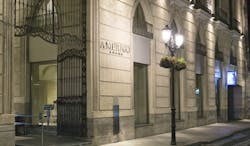
The Hospes Amerigo Alicante is a charming 5-star boutique hotel in a central location in Alicante’s old town. Delicious cuisine, excellent spa facilities and a rooftop terrace with views of the Santa Barbara Castle offer a luxurious and indulgent experience.
Dreamer room

Hospes Palau de la Mar is a 5-star boutique hotel, a peaceful retreat in the heart of Valencia. Delicious cuisine and excellent spa facilities and beautiful location next to the Turia Gardens offer an indulgent and restorative experience.
Dreamer room
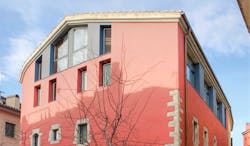
Hotel Llegendes de Girona is an exclusive 4-star hotel in an excellent central location. With delicious cuisine and comfortable accommodation which combines elements of the original stone structure and modern facilities, it is a haven from the bustle of Girona.
Standard double
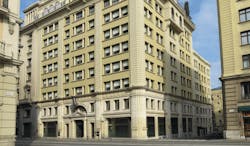
Grand Hotel Central Barcelona is a luxury 5-star hotel in an excellent city centre location. Excellent spa facilities, delicious cuisine and stunning rooftop pool make it an ideal spot to recuperate after a day enjoying the city's sights.
Executive double
This holiday can be arranged throughout the year. Additional nights can be added at any point on this itinerary. Timings can vary depending on the month and day of the week.
It has been a lovely holiday & once again, you did not disappoint. Thank you again for everything. We look forward to contacting you again for our next adventure.Mrs H, July 2025
Holiday price guide Prices from £2,580 per person based on two people sharing a double or twin room.
Holiday Code SNFR09
Call us on 01392 441245
Costa Blanca to Catalonia luxury fly-rail touring holiday
About Catalonia and Eastern Spain
An Expressions tailor-made holiday to eastern Spain feature some of the best four and five star hotels in Catalonia and Valencia, including luxury beach resorts on the Costa Brava, mountain retreats in the Catalan Pyrenees and city hotels in Barcelona and Valencia. Eastern Spain is a diverse area with buzzing cities and mediaeval towns, rugged coastline and sandy beaches, soaring mountains and lush river deltas. There is a great wealth of historical and cultural sights throughout Catalonia and the Valencian community, both within the main cities and hidden away in the countryside. Although Barcelona is the main draw for visitors to eastern Spain, the rest of the region is well worth visiting and offers tremendous diversity. During a holiday in eastern Spain, visitors can trek or partake in mountain sports, relax on the beach and visit historic towns and cities all within the space of a few days. Catalonia itself is a unique region which provided inspiration for a number of famous artists such as Dali and Picasso, and retains a strong regional identity which is evident in its language, distinctive cuisine and lively local festivals. In the north is Catalonia, whose capital is the dynamic and cosmopolitan city of Barcelona. With unique architecture and a rich culture, gourmet restaurants and lively bars, golden beaches and tranquil parks, it is not surprising that Barcelona is one of the most visited cities in Europe. Away from the city there is an abundance of cultural and historical attractions as well as areas of stunning natural beauty. The entire region retains a strong regional identity, with its own commonly used language, distinctive cuisine and lively local festivals. Towns and cities including Girona, Tarragona, Vic and Lleida are home to a variety of highlights including mediaeval castles, cobbled old towns, ancient Roman ruins and modernist architecture. Stretching north towards the French border are the pretty coves, jagged cliffs and golden beaches of the Costa Brava, where you can still find wild and untouched stretches of coastline in between busy coastal towns. Meanwhile, inland are the snow-capped Pyrenees, a towering mountain range which forms the border with France and is dotted with remove villages, an ideal setting for trekking and partaking in mountain sports. Past the vineyards and rice fields of southern Catalonia is the Valencian Community, whose capital is Spain's third-largest city. Valencia has reinvented itself in recent years with futuristic architecture and a sophisticated port area which contrast with the historic buildings of the atmospheric old town. Further south are the sprawling beach resorts of the Costa Blanca, but if you head away from the Valencian coastline you will find craggy mountains, peaceful nature reserves, colourful citrus groves, traditional villages and ancient fortresses.
Highlights of Catalonia and Eastern Spain
Barcelona's Gothic quarter, a maze of narrow streets and plazas which is home to historic buildings including La Seu Cathedral. Modernist architecture throughout the region, particularly in Barcelona where Gaudí designed works including the Sagrada Familia church and Park Guell. Green spaces within Barcelona such as Montjuic, a fortress-topped hill, and Parc de la Ciutatella, a popular park with a zoo and several museums. The City of Arts and Sciences and the Fine Arts Museum in Valencia. Historic monuments within Valencia including a 15th century silk exchange and a Cathedral, home to a Holy Chalice which is said to be the Holy Grail. The Monastery of Montserrat, a religious complex in a spectacular setting atop craggy mountains with chapels, hermits' caves and numerous nature trails. Wineries in towns such as Sant Sadurní d'Anoia and Vilafranca del Penedès. Tarragona, a port city with fascinating Roman remains. The ancient walled city of Girona. Vic, a quintessentially Catalan town with an outstanding market. Cardona, a picturesque town with an impressive fortress. The renowned Dalí Theatre-Museum in Figueres. Charming towns along the Costa Brava such as Cadaques, as well as those further inland such as the colourful town of Begur. Pretty villages in the Pyrenees, where visitors can also hike and partake in mountain activities. Wildlife in the wetlands of the Albufera Natural Park.
Festivals in Catalonia and Eastern Spain
March: Las Fallas festival of fire (Valencia), 23 April: Celebration of Catalonia's patron saint, April: Barcelona April Fair, May: Girona flower fair, 23 June: Midsummer's Eve Festival, July: Valencia July Fair, July/August: Begur Music Festival, August: La Tomatina tomato throwing festival (Buñol), 11 September: National day of Catalonia, September: Celebration of Barcelona's patron saint, September/October: Human tower festivals (near Tarragona).
Gastronomy in Catalonia and Eastern Spain
Cuisine in eastern Spain takes inspiration from both nearby France and from central Spain whilst making use of local ingredients available including seafood, fresh vegetables, meat and game. Paella, the rice dish which is known the world over originated in Valencia. Barcelona is home to some of Spain's best restaurants, with gastronomic chefs creating innovative cuisine and over 20 boasting at least one Michelin star. Typical dishes include unusual ‘sea and mountain' combinations which use both meat and seafood, ‘Pa amb tomàquet' (bread with tomato, oil and garlic), ‘Fideuá' (a variant of Paella with pasta), ‘Zarzuela' (a seafood stew), ‘Escudella’ (a stew containing vegetables, meat, rice and pasta) and ‘Crema Catalana' (a Catalan version of a Crème Brûlée).
Climate in Catalonia and Eastern Spain
Eastern Spain enjoys a typical Mediterranean climate, although mountainous areas are somewhat cooler. Late spring and early autumn are great times to visit coastal areas as the weather is warm with temperatures of around 20 degrees centigrade, although some rainfall can be expected. Summer in the cities can be unbearably hot, but the coastline is cooled by sea breezes. Winter is generally mild with occasional rain and average temperatures of 10 degrees, whilst temperatures regularly drop below freezing in the Pyrenees and snow often falls.
Call us on 01392 441245
Costa Blanca to Catalonia luxury fly-rail touring holiday
About Valencia and Murcia
The regions of Valencia and Murcia offer the chance to explore the long stretch of Spain’s eastern coast and the contrasting landscapes found inland. Picturesque villages lie scattered along the shore between larger towns, many of which have been overlooked by mass market tourism and are still beautifully authentic. The inland reaches of these regions vary drastically from fertile groves of oranges, dates and even rice to arid deserts spotted with isolated white buildings and hilltop towns. Valencia is another semi-independent region with its own language, valenciano. The language is derived from Catalan and has many similarities but it’s unwise to comment on this to a local as they are fiercely proud of their unique identity. Alongside valenciano and Castilian Spanish there is also the legacy of the long Arab occupation. On a stunning beach of golden sand is the regional capital of Valencia, Spain’s third-largest city. Visitors to this region must be sure to try a real paella as the famous dish originated here. There are countless combinations of flavours and ingredients to be tried in the restaurants, but the most traditional option is rabbit and chicken in a vibrant saffron rice. Valencia has reinvented itself in recent years with futuristic architecture and a sophisticated port area which contrast with the historic buildings of the atmospheric old town. On the other hand, Murcia is a historic city which is particularly noted for its Baroque cathedral and tapas scene. Between these two locations you will find the bustling town of Denia, launching point for ferries to the Balearic Islands. A historic port founded by the Romans, Denia has a hilltop castle, ancient fishing neighbourhood and beautiful beaches. The regions of Valencia and Murcia are particularly known for their festivals and two of Spain’s most iconic fiestas are held here. The crazy tomato fight of La Tomatina is Bunol is probably not to everyone’s taste, however the spring celebration of Las Fallas is highly recommended – a month filled with fireworks, huge bonfires and giant puppets that are set on fire at the end of the festivities. Booking in advance for this unique festival is essential.
Highlights of Valencia and Murcia
The City of Arts and Sciences and the Fine Arts Museum in Valencia. Historic monuments within Valencia including a 15th century silk exchange and a Cathedral, home to a Holy Chalice which is said to be the Holy Grail. Wildlife in the wetlands of the Albufera Natural Park. The lively university city of Murcia with Moorish fortified walls, Baroque cathedral and wealth of tapas bars. The Castell de la Santa Bárbara and Museo Arqueológico Pronvicial, giving the best views over the city of Alicante. The historic port town of Denia with its beautiful beaches, hilltop castle, former fishing neighbourhood or Baix la mar and Moorish influenced distrcit of Les Roques. Walking in Montgó Natural Park. Swimming at the secluded Les Rotes beach and nearby Cova Tallada (reached by boat or on foot). The town of Morella is the northern reaches of Valencia with its medieval fortified town and 13th century aqueduct. The iconic Penon de Ifach rock in the heart of Calpe. The colourful port city of Cartagena with its Roman Theatre, Castillo de la Concepcion and beautiful seafront promenade.
Festivals in Valencia and Murcia
March: Las Fallas festival of fire (Valencia), La Magdalena festivities in Castellon de la Plana. April: Easter celebrations and religious processions, Night of the Drums (Mula), Moor and Christians re-enactment fiesta in Banyeres de Mariola, Spring celebrations in Murcia including the “Burial of the Sardine”. June: Bonfires of San Juan Midsummer’s Eve Festival (Alicante). July: Valencia July Fair. August: La Tomatina tomato throwing festival (Bunol), August Fair in Xativa, the Corda fire festival in Paterna, Sexenni festival in Morella (every 6 years). September: Bull and horse droving in Segorbe, Murcia Fair, Romans and Carthaginians re-enactment in Cartagena.
Gastronomy in Valencia and Murcia
Cuisine in eastern Spain takes inspiration from both central Spain and the Arab influences of its past whilst making use of local ingredients available including seafood, fresh vegetables and game. Valencia and Murcia host many restaurants specialising in shellfish and fish, with fish often cooked in a salt crust or ‘a la espalda’ (lightly fried and baked). Paella, the vibrant rice dish which is known the world over originated in Valencia. Typical dishes include unusual ‘sea and mountain' combinations which use both meat and seafood, ‘Pa amb tomàquet' (bread with tomato, oil and garlic), ‘Fideuá' (a variant of Paella with pasta), ‘Zarzuela' (a seafood stew), ‘Escudella’ (a stew containing vegetables, meat, rice and pasta) and ‘Crema Catalana' (a Catalan version of a Crème Brûlée).
Climate in Valencia and Murcia
Valencia and Murcia enjoy a typical Mediterranean climate, although higher areas are somewhat cooler. Late spring and early autumn are great times to visit coastal areas as the weather is warm with temperatures of around 20 degrees centigrade, although some rainfall can be expected. Mid-summer in the cities can be unbearably hot, but the coastline is cooled by sea breezes. Winter is generally mild with occasional rain and average temperatures of 10-15 degrees, making this a favoured destination for cultural exploration year-round.

